The ZZ plant is a well-liked indoor plant celebrated for its eye-catching appearance and minimal upkeep needs. Although these plants are generally simple to maintain, they can be susceptible to specific issues.
ZZ plant leaves curling is one such prevalent problem, and it may be worrisome. If this happens to your plant, don’t fret – our extensive guide is at your service.
This write-up delves into the seven typical reasons behind ZZ plant leaf curl, the signs of being vigilant, and the preventive measures to ensure your plant remains robust and flourishing.
This article caters to both experienced plant lovers and novices, providing all the necessary information to tackle the challenges of ZZ plant leaves curling and maintain your plant’s pristine appearance.
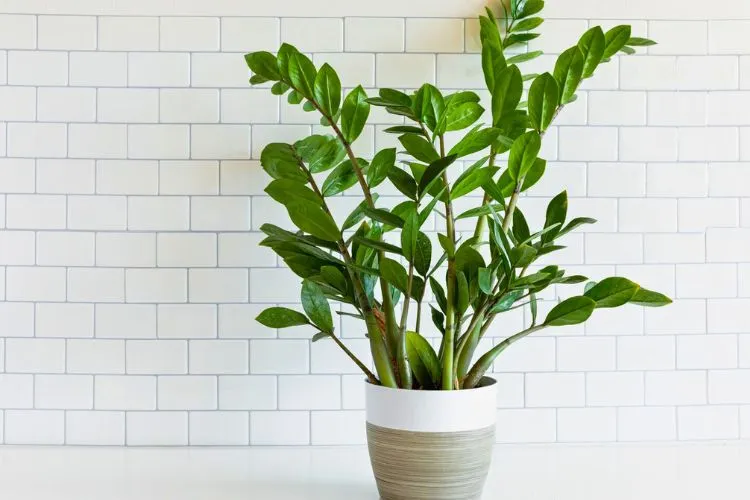
Table of Contents
7 Common Causes of ZZ plant leaves curling
Within this portion of our article, we will examine seven common elements that lead to the curling of ZZ plant leaves, providing an in-depth overview of each reason and advice on addressing these challenges successfully.
Overwatering
Overwatering is a frequent mistake by plant owners, and ZZ plants are no exception. Though these plants can withstand drought, excessive moisture in the soil can lead to problems such as leaf curling.
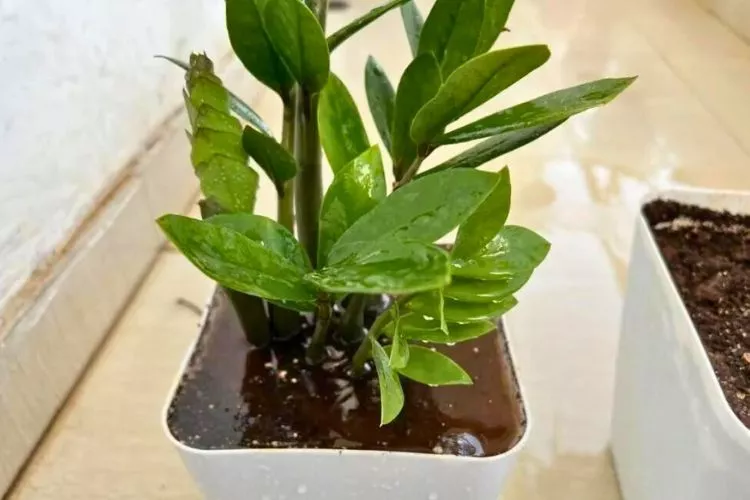
Signs of Overwatering
- Yellowing leaves
- Soft, mushy stems
- Wilting, even when the soil is wet
How Overwatering Leads to Leaf Curling
Overwatering occurs when a plant receives more water than it can use or store. This excess water saturates the soil, depriving the roots of the oxygen they require to function properly. As a result, the roots may begin to rot, and the plant becomes stressed.
Example: Suppose a plant owner waters their ZZ plant every two days, even though the top 1-2 inches of soil remain moist. This watering schedule can lead to overwatering, as the plant cannot use the water before more is added. Consequently, the plant’s roots may suffer, and its leaves may curl as a symptom of stress.
How to Fix Overwatering
- Remove the plant from its pot and inspect the roots for damage.
- Trim away any black or mushy roots.
- Repot the plant in a well-draining soil mix and a container with proper drainage holes.
Prevention Tips
- Use well-draining soil.
- Water only when the top 1-2 inches of soil are dry.
- Avoid letting the plant sit in water for extended periods.
Underwatering
Though ZZ plants are drought-tolerant, they still require adequate water to thrive. Underwatering can lead to leaf curling as the plant struggles to maintain hydration.
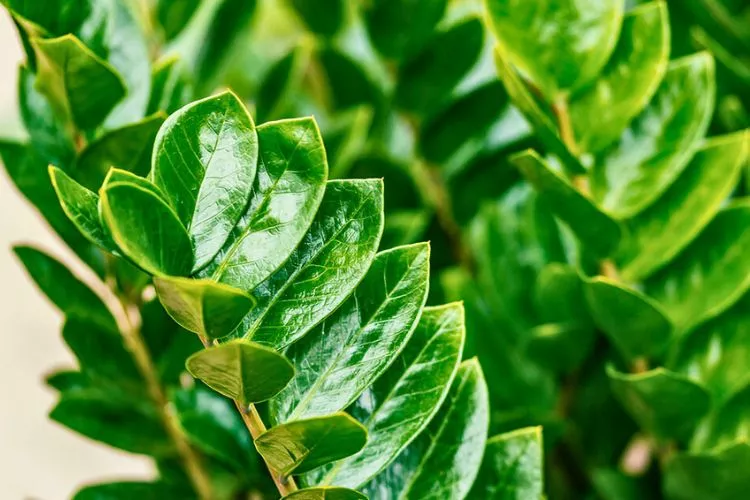
Signs of Underwatering
- Dry, crispy leaves
- Wilting or drooping
- Slow growth
How Underwatering Leads to Leaf Curling
Underwatering occurs when a plant doesn’t receive enough water to meet its needs. This deficiency may be due to infrequent watering, shallow watering that doesn’t reach the root zone, or environmental factors, such as excessive heat or low humidity.
Example: If a ZZ plant is placed near a heating vent and only watered once a month, it may experience underwatering. The combination of high heat and insufficient watering can lead to dehydration, causing the plant’s leaves to curl to conserve water.
How to Fix Underwatering
- Slowly increase the plant’s watering schedule, being careful not to overwater.
- Trim away severely dehydrated leaves to encourage new growth.
- Ensure the plant is in a suitable environment, avoiding excessive heat or drafts.
Prevention Tips
- Check the soil’s moisture regularly.
- Create a consistent watering schedule based on the plant’s needs.
Lack of humidity
ZZ plants can adapt to various humidity levels, but low humidity can lead to leaf curling as the plant struggles to retain moisture.
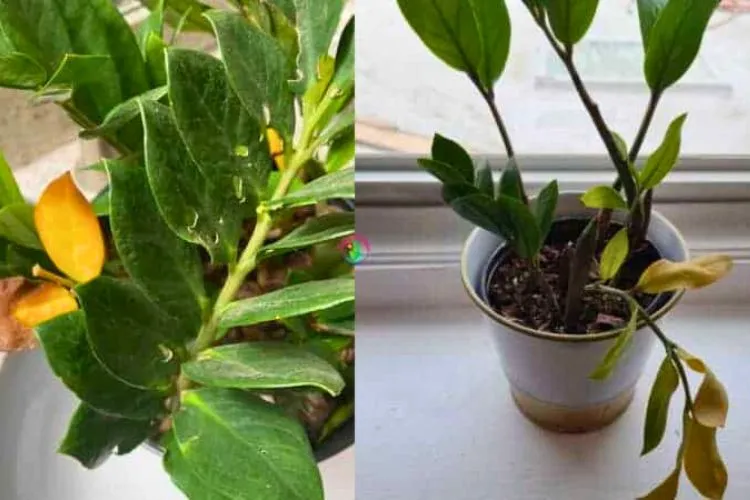
Signs of Low Humidity
- Brown leaf tips
- Leaf curling or cupping
- Stunted growth
How Low Humidity Leads to Leaf Curling
ZZ plants originate from tropical areas where humidity is typically high. In environments with low humidity, water evaporates quickly from the plant’s foliage, resulting in the plant losing moisture faster than it can replenish.
For example, a ZZ plant in a room with a forced-air heating system might encounter low humidity since this kind of heating can dehydrate the air. Consequently, the plant’s leaves might curl to reduce moisture loss and defend the plant against dehydration.
How to Increase Humidity Levels
- Group plants together to create a microclimate with higher humidity.
- Place a tray of water with pebbles near the plant.
- Use a humidifier or mist the plant regularly.
Prevention Tips
- Keep the plant away from heat sources or drafts.
- Maintain a consistent humidity level in the plant’s environment.
Exposure to direct sunlight
While ZZ plants enjoy bright, indirect light, direct sunlight can cause sunburn and leaf curling.
Signs of Sunburn on ZZ Plant
- Yellow or white spots on leaves
- Crispy, burnt edges
- Leaf curling or distortion
How Sunburn Leads to Leaf Curling
ZZ plants are adapted to grow in the understory of forests, where they receive filtered sunlight. Direct sunlight can be too intense for these plants, causing damage to their leaves and potentially leading to sunburn.
Example: If a ZZ plant is placed on a sunny windowsill without shade, it may receive direct sunlight for several hours each day. This exposure can cause the plant’s leaves to become sunburned, leading to curling and distortion as the plant tries to protect itself from further damage.
How to Prevent Sunburn
- Gradually acclimate your ZZ plant to brighter light, avoiding sudden changes in light intensity.
- Place the plant near a window with filtered light, such as through sheer curtains.
- Use blinds or shades to protect the plant during peak sunlight hours.
Prevention Tips
Monitor the plant’s light exposure, adjusting as needed.
Rotate the plant regularly for even light distribution.
Pest infestation
Pests can attack ZZ plants; some may cause leaf curling as they feed on the plant’s sap, weakening its overall health.
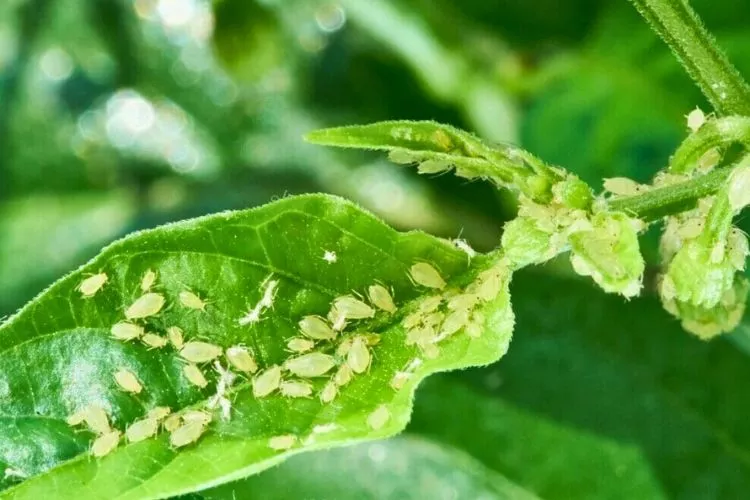
Common Pests Affecting ZZ Plant
- Aphids
- Spider mites
- Mealybugs
Signs of Pest Infestation
- Sticky residue or honeydew on leaves
- Webbing or tiny insects on the plant
- Leaf discoloration or curling
How Pest Infestation Leads to Leaf Curling
Pests, such as aphids, spider mites, and mealybugs, can infest ZZ plants and cause damage by feeding on the plant’s sap. This feeding activity weakens the plant and can lead to losing essential nutrients and water.
Example: A ZZ plant with a severe aphid infestation may experience leaf curling as the plant becomes weakened and stressed. The aphids’ feeding activity removes vital nutrients and water from the plant, causing its leaves to curl in response to the stress.
How to Treat Pest Infestation
- Remove visible pests with a soft cloth or cotton swab dipped in soapy water.
- Follow the manufacturer’s instructions to spray the plant with insecticidal soap or neem oil.
- In severe cases, consider using systemic insecticides as a last resort.
Prevention Tips
- Inspect new plants for pests before bringing them home.
- Maintain a clean and healthy environment for your ZZ plant.
- Keep humidity levels in check, as certain pests thrive in dry conditions.
Root rot
Root rot, often caused by overwatering, can lead to leaf curling as the plant’s health deteriorates.
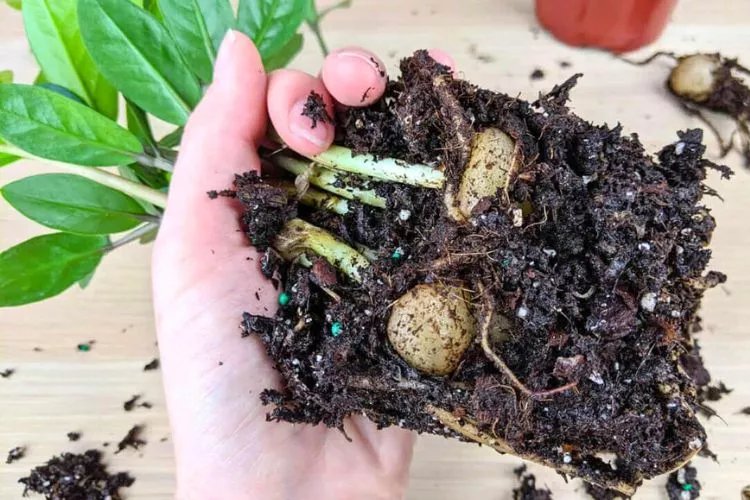
Signs of Root Rot
- Black, mushy roots
- Foul odor from the soil
- Yellowing or wilting leaves
How Root Rot Leads to Leaf Curling
Root rot is a fungal or bacterial infection that affects a plant’s roots, often caused by overwatering or poor drainage. When the roots are compromised, the plant’s ability to take up water and nutrients is significantly reduced, leading to stress and symptoms such as leaf curling.
Example: A ZZ plant that is consistently overwatered and has poorly draining soil may develop root rot. As the infection spreads through the root system, the plant cannot take up water and nutrients effectively, leading to stress and the subsequent curling of its leaves.
How to Fix Root Rot
- Remove the plant from its pot and trim away the affected roots.
- Allow the remaining healthy roots to dry for a day or two.
- Repot the plant in fresh, well-draining soil and a container with drainage holes.
Prevention Tips
- Use well-draining soil and a pot with proper drainage.
- Avoid overwatering the plant.
- Ensure the plant has proper airflow and is not overcrowded.
Nutrient deficiencies
ZZ plants require specific nutrients to thrive, and a lack of these can lead to leaf curling.
Common nutrient deficiencies in ZZ plant
- Nitrogen
- Phosphorus
- Potassium
- Magnesium
Signs of Nutrient Deficiencies
- Yellowing or pale leaves
- Slow or stunted growth
- Leaf curling or distortion
How Nutrient Deficiencies Lead to Leaf Curling
To flourish and develop, plants need specific nutrients. If a plant fails to obtain the necessary nutrients, it might become strained and display signs such as leaf curling.
Factors contributing to nutrient deficiencies include subpar soil quality, incorrect fertilization, or environmental conditions that hinder nutrient absorption.
For instance, a ZZ plant cultivated in nutrient-depleted soil without the right fertilization might experience a magnesium shortage. This deficiency could result in leaf curling, as the plant cannot effectively execute vital functions without adequate magnesium.
In this scenario, the curling of the plant’s leaves may react to the stress induced by the nutrient discrepancy.
How to Provide Adequate Nutrients
- Perform a soil test to identify the specific deficiency.
- Apply a balanced, slow-release or liquid fertilizer at the recommended dilution.
- Consider supplementing with micronutrients like Epsom salt (magnesium sulfate) if necessary.
Prevention Tips
- Use high-quality, nutrient-rich potting soil.
- Monitor the plant’s overall health and adjust its care accordingly.
- Follow a regular fertilization schedule based on the plant’s needs and growing season.
Possible Signs of ZZ plant leaves curling
In this portion of our article, we will discuss potential indicators of ZZ plant leaves curling, delving into the scientific reasons behind each symptom and their related causes.
You can effectively manage and prevent leaf curling problems by understanding these signs and their underlying mechanisms.
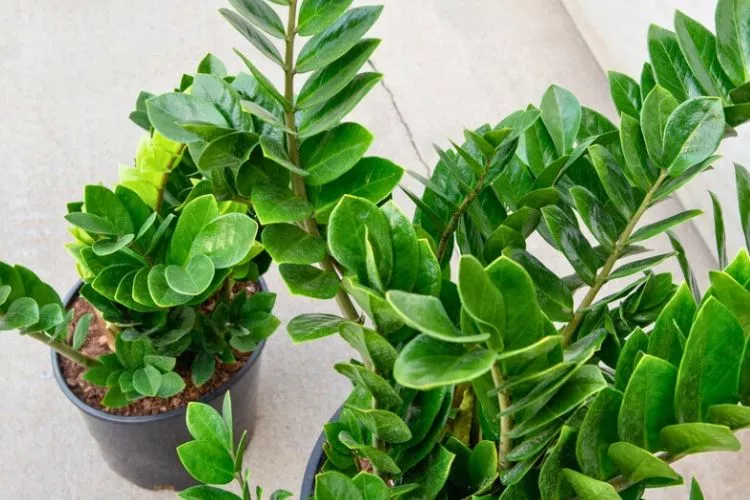
Brown spots on leaves
Brown spots on ZZ plant leaves can signify issues such as overwatering, sunburn, or fungal infections.
- Overwatering can lead to root rot due to oxygen deprivation in the roots, which subsequently causes the leaves to develop brown spots due to cell damage.
- Sunburn occurs when the plant is exposed to excessive direct sunlight, leading to photoinhibition, impairing the plant’s photosynthetic process, and ultimately resulting in brown spots.
- Lastly, fungal infections can cause brown spots, particularly if the plant is maintained in a consistently moist environment, fostering the growth of pathogenic fungi that invade the plant’s cells and trigger localized tissue necrosis.
Yellowing of leaves
The yellowing of leaves in ZZ plants can be attributed to various factors, such as underwatering, overwatering, nutrient deficiencies, or natural aging.
- Underwatering forces the plant to deplete its stored water reserves, leading to chlorophyll and yellowing leaves breakdown.
- Overwatering can lead to root rot, which hinders proper nutrient and water absorption, causing chlorosis (yellowing) in the leaves.
- Nutrient deficiencies, particularly nitrogen, can also result in the yellowing of leaves, as nitrogen is a crucial component of chlorophyll, the green pigment responsible for photosynthesis.
- Lastly, leaves can naturally yellow and fall off as the plant undergoes senescence, a programmed cell death process that reallocates nutrients to new growth.
Wilting of leaves
Wilting in ZZ plants can be caused by underwatering, overwatering, or pest infestations.
- Underwatering results in a lack of moisture within the plant’s cells, causing turgor pressure loss and wilting leaves.
- Overwatering can cause root rot, impacting the plant’s ability to absorb water, reducing water flow to the leaves and wilting.
- Pests, such as aphids or spider mites, may feed on the plant’s sap, depleting essential nutrients and water content, weakening the plant and causing wilting.
Drying of leaves
Drying leaves in ZZ plants can result from low humidity, underwatering, or excessive heat.
- Low humidity accelerates transpiration, the process of losing water through the plant’s leaves, causing the leaves to dry out.
- Underwatering prevents the plant from obtaining adequate moisture, resulting in dehydration and leaf desiccation.
- Excessive heat, especially when combined with low humidity or underwatering, can exacerbate transpiration and cause the leaves to dry out more rapidly.
How to fix ZZ plant leaves curling
In this part of our article, we will concentrate on various strategies to address the problem of ZZ plant leaves curling. By understanding the scientific underpinnings of these solutions, you can effectively resolve leaf curling and improve the overall health of your ZZ plant.

Reduce watering frequency
One effective technique for mitigating leaf curling in ZZ plants is to reduce watering frequency. This entails allowing the soil to partially dry between waterings, which helps maintain an optimal moisture balance for the plant.
Consequently, this practice supports healthy root growth and ensures proper nutrient uptake, ultimately contributing to the prevention of leaf curling. Reducing the watering frequency can minimize the risk of root rot and oxygen deprivation, allowing the roots to function optimally and support the plant’s health.
Increase humidity levels
Another method to combat leaf curling is to elevate the humidity levels around the plant. This can be achieved by regularly misting the plant’s leaves, placing a water-filled tray near the plant, or using a humidifier.
Increasing humidity levels maintains the plant’s turgor pressure, and the transpiration rate is reduced. As a result, leaf curling due to excessive water loss is prevented. High humidity levels mimic the natural environment of ZZ plants, ensuring their proper physiological functioning.
Move the plant away from direct sunlight
Protecting ZZ plants from photoinhibition, which impairs photosynthesis and leads to leaf damage, is crucial. To do this, relocate the plant to a location with bright, indirect light, such as near a north-facing window or behind a sheer curtain.
By providing filtered light, the risk of photoinhibition is minimized, enabling the plant to carry out photosynthesis effectively without causing damage to its leaves. This relocation can prevent leaf curling caused by sunburn or other light-induced stress.
Treat pest infestation
Managing pest infestations is essential for the health of ZZ plants. To do so, use appropriate treatments, including insecticidal soap, neem oil, or targeted pesticides, depending on the pest affecting your plant. Remove any severely infested leaves to prevent the infestation from spreading further.
The plant’s overall health is maintained by treating and preventing pest infestations, and the likelihood of leaf curling due to pest-induced stress is reduced. A healthy plant is more resistant to pest attacks and better equipped to recover from any damage caused by pests.
Re-pot the plant
Re-potting a ZZ plant in a larger container with fresh, well-draining soil can encourage root growth and supply essential nutrients. When re-potting, ensure the new container has drainage holes and use a soil mix specifically designed for ZZ plants or other tropical plants.
Proper re-potting fosters healthy root development and nutrient uptake, helping to prevent leaf curling caused by root constriction or nutrient deficiencies. This process also enables the plant to access a wider range of nutrients, promoting its overall health and growth.
Provide adequate nutrients
Addressing nutrient deficiencies is vital for the well-being of ZZ plants. Use a balanced, slow-release fertilizer formulated for houseplants, adhering to the recommended application rates and frequencies.
The plant can maintain proper cellular function, photosynthesis, and growth by providing the necessary nutrients, reducing the risk of leaf curling due to nutrient imbalances. A well-nourished plant is more resilient and can better withstand environmental stresses that could otherwise lead to leaf curling.
Pro tips to prevent ZZ plant leaves curling
Now that we have worked out any possible problems and fixed them let’s look at some often forgotten tips to ensure your ZZ plant stays happy, healthy and uncurled.
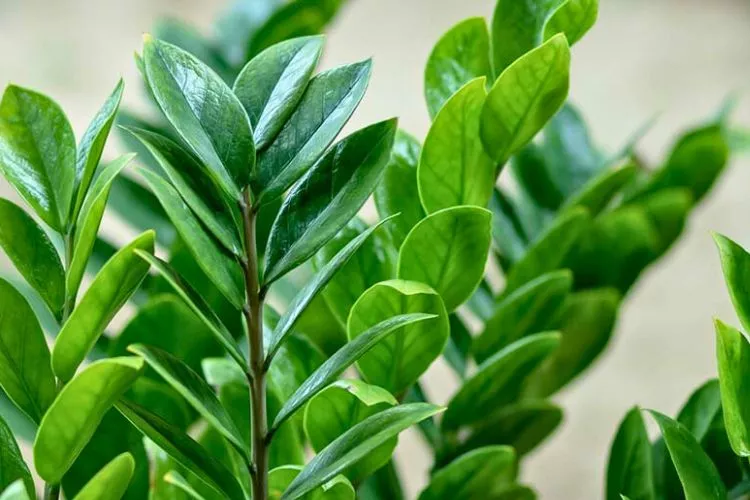
Use well-draining soil
Choosing the right soil for your ZZ plant is crucial in preventing leaf curling. A well-draining soil mix helps prevent waterlogging and root rot, allowing excess water to drain away from the plant’s roots.
Consider using a soil mix designed specifically for tropical plants, or create your mix by combining equal parts of peat moss, perlite, and regular potting soil. This well-draining soil composition will encourage healthy root growth and prevent leaf curling caused by overwatering or oxygen deprivation.
Water only when the soil is dry
To maintain proper moisture levels for your ZZ plant, it is essential to water only when the soil is dry. To determine the right time to water, insert your finger about an inch into the soil; if it feels dry at that depth, it’s time to water your plant.
By adhering to this watering guideline, you can prevent the overwatering that often leads to leaf curling. Moreover, this practice helps maintain an optimal soil balance of moisture and oxygen, promoting healthy root growth and overall plant well-being.
Avoid over-fertilization
Over-fertilization can lead to nutrient imbalances and toxicity, which can cause leaf curling in ZZ plants. To prevent this issue, use a balanced, slow-release fertilizer specifically designed for houseplants and apply it according to the manufacturer’s recommendations.
Avoiding excessive fertilization can provide your ZZ plant with the necessary nutrients without causing harm. This approach ensures the plant has access to the nutrients it needs for proper growth and functioning without the risk of leaf curling due to nutrient imbalances.
Maintain optimal temperature and humidity levels
Keeping your ZZ plant in a comfortable environment is crucial for its health. Maintain a consistent temperature between 65°F and 75°F, and avoid placing your plant near drafty windows or heating vents, which can cause fluctuations in temperature.
Additionally, maintain a relative humidity level of at least 40% around the plant. This can be achieved by using a humidifier, placing a tray of water near the plant, or misting the leaves regularly.
Maintaining optimal temperature and humidity levels can prevent leaf curling caused by environmental stress and ensure the plant’s well-being.
Clean the leaves regularly
Cleaning the leaves of your ZZ plant is essential for maintaining its health and preventing leaf curling. Dust and debris can accumulate on the leaves, blocking sunlight and reducing the plant’s ability to photosynthesize effectively.
Gently wipe the leaves with a damp cloth or soft sponge at least once a month to remove dust and debris. Regular cleaning also helps to prevent pests from settling on the leaves, which can cause leaf curling if left unchecked.
Frequently Asked Questions (FAQs)
How often should I water my ZZ plant?
Water your ZZ plant only when the soil is dry, typically every 2-3 weeks. Check by inserting your finger about an inch into the soil before watering.
What is the ideal temperature range for a ZZ plant?
For optimal growth and health of a ZZ plant, maintain a temperature range between 65°F and 75°F, providing an agreeable atmosphere for its development.
Can I use tap water to water my ZZ plant?
Yes, you can use tap water for your ZZ plant. However, if your tap water has high chlorine content, let it sit for 24 hours before using it to allow the chlorine to dissipate.
Conclusion:
To sum up, we have delved into the prevalent reasons for ZZ plant leaves curling, including overwatering, underwatering, insufficient humidity, exposure to direct sunlight, pest infestations, root rot, and nutrient deficiencies.
Grasping these causes and associated symptoms enables you to tackle and avert leaf curling effectively. We’ve also shared advice on maintaining a flourishing ZZ plant through proper watering, soil choice, and ideal environmental conditions.
Your ZZ plant’s well-being and appearance rely on your capacity to address and prevent leaf curling problems. Adopting preventive measures and attentive care will ensure your plant remains vibrant and healthy for years.
We believe this guide on ZZ plant leaves curling has been useful. Discover more related topics on our website and return soon for additional insights.


